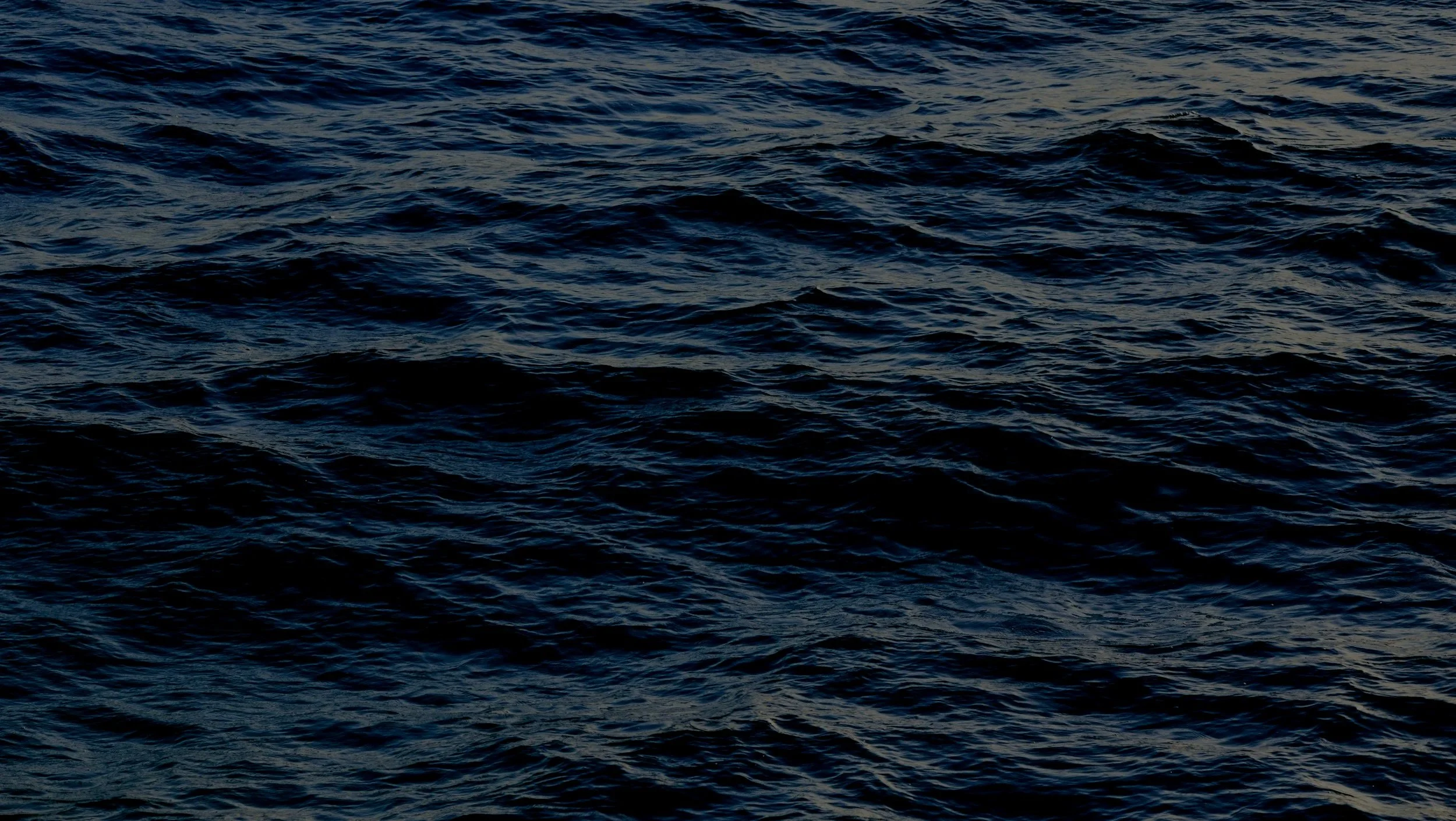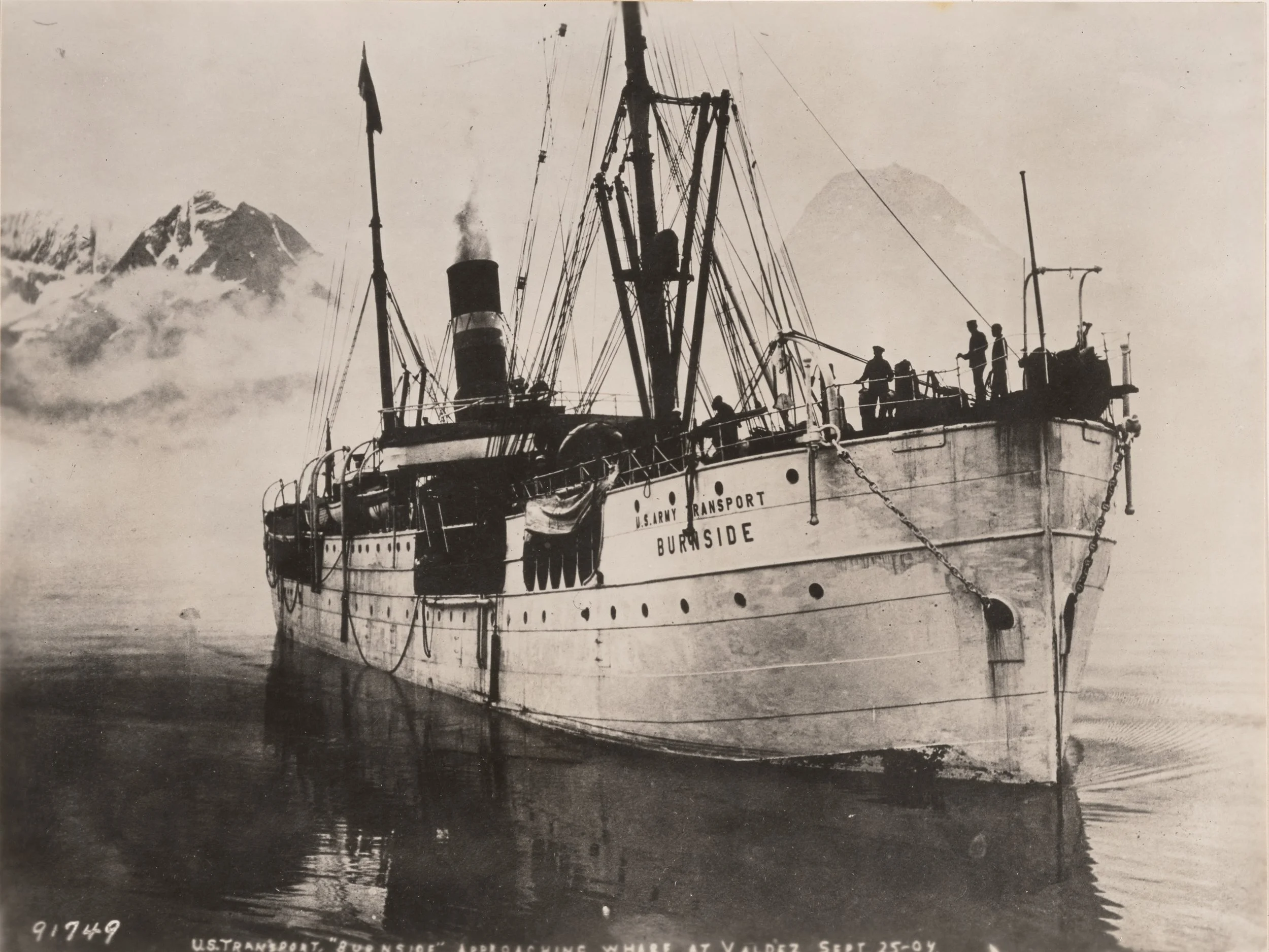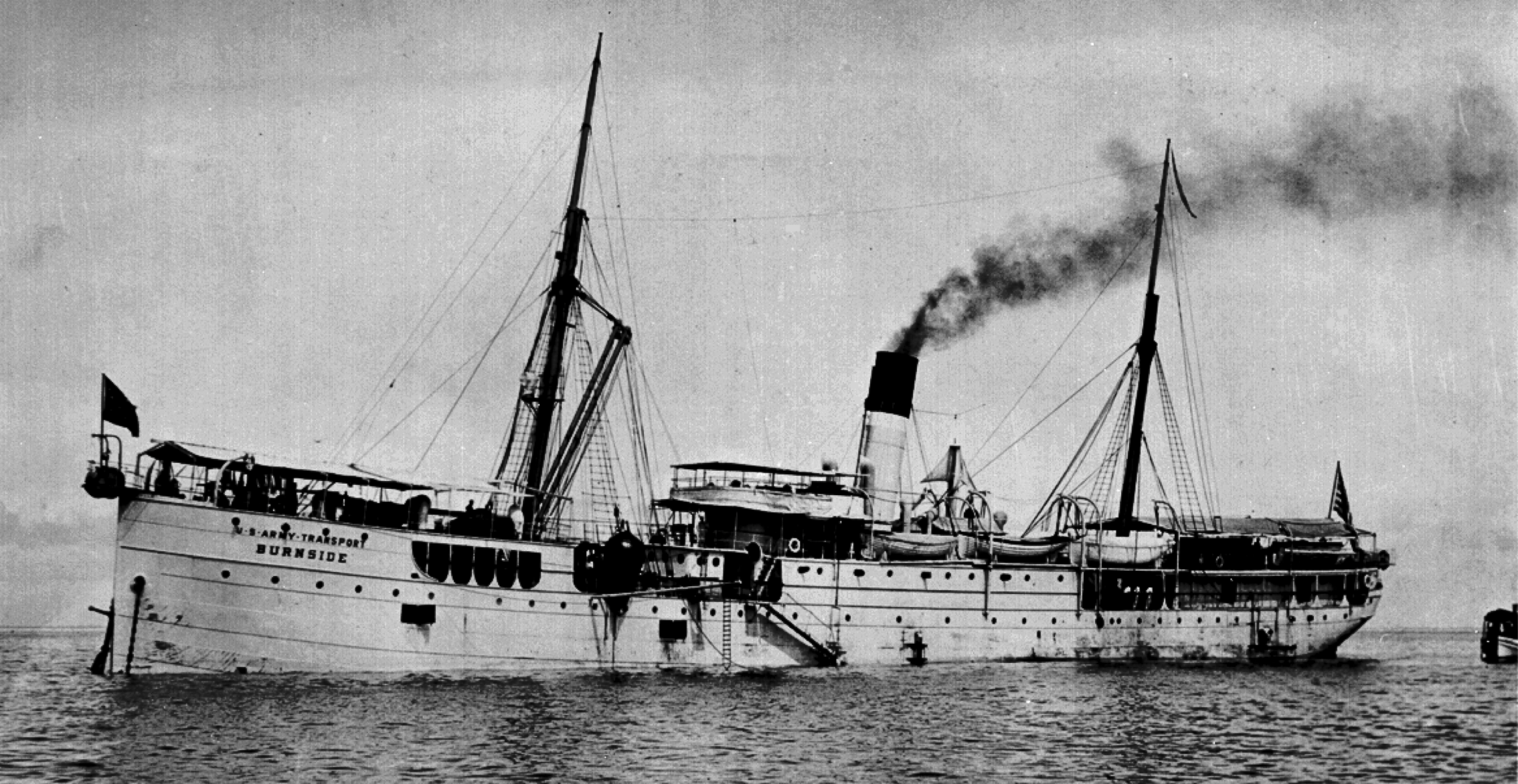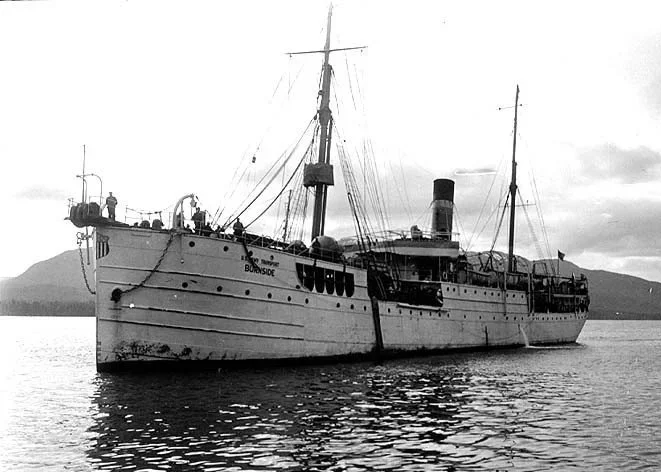


The Hattie Gage
(82’ Length, 20’ Beam, 81 Tons) The Hattie Gage launched in 1889. The San Francisco Chronicle reported the ship was 82 feet long, 20 feet wide, and featured compound engines capable of 10 knots. The newspaper said: “Even without much ballast the vessel rides the waves beautifully.” The Hattie Gage entered the service of the APA almost immediately, and it was a regular fixture of the Wrangell cannery.
This photograph above likely shows the Hattie Gage on the morning of September 19, 1908 before the Star of Bengal was towed out to sea. There is a photo of a similar party aboard the stern of the Star of Bengal. The man standing with his hands on his hips appears to be Captain Erwin Farrer. (photo credit: Michael and Carolyn Nore Collection)
Following the rescue of the Star of Bengal survivors, work crews came back to Coronation Island to handle the human remains on the beach. This photograph shows the Hattie Gage in the distance, with the rocky beach on which the survivors landed in the foreground. (photo credit: San Francisco Maritime National Historic Park)
The Hattie Gage was designed as a fish tender. As fish traps filled up, the tender arrived regularly to be restocked with fresh, whole salmon to be taken to the cannery, where it would be turned into canned food. When it was not running a route, the Hattie Gage tied up at the Wrangell cannery. In 1918, the Hattie Gage capsized off the coast of North Carolina, and sunk. (photo credit: Michael and Carolyn Nore Collection)

The Kayak
(91’ Length, 115 Tons) In 1908, the steamship Kayak was relatively new, only seven years old, designed and built in California for the APA as a fish tender. In 1907, the Kayak towed the Star of England alongside the 42-ton steamship, Arctic. High seas made it impossible to navigate, and the ships sheltered at anchor for three days. In fact, a design flaw in the Kayak meant that its rudder often came out of the water in high seas, preventing it from navigating. (photo credit: San Francisco Maritime National Historic Park)
In 1913, just five years after the Star of Bengal sank, the Kayak ran into high seas outside Yakutat. The ship attempted to turn, hit rocks, and sank. The crew narrowly escaped aboard lifeboats. Said the Alaska Daily Empire: “The Kayak has a dark record. This boat had in tow the Star of Bengal when she was wrecked and 138 people perished. She has been a sort of trouble maker, it is said, ever since she took to the water and every seaman who ever shipped aboard her was glad when his time was out.” (photo credit: Michael and Carolyn Nore Collection)
Eventually, the Kayak wasted away in the surf, a fading reminder of the danger of the high seas. (photo credit: Michael and Carolyn Nore Collection)

The Chilkat
(115’ Length, 24’ Beam, 172 Tons) For two years, the 172-ton steamship Chilkat single-handedly towed the Star of Bengal to and from sea. But on the morning of September 19, 1908, the Chilkat wasn’t there. To compensate, Superintendent Jacob Babler of the Wrangell APA cannery arranged for the Hattie Gage and the Kayak to tow the Star of Bengal together.
Following the wreck of the Star of Bengal, the Alaska Sentinel lambasted the APA for not using the Chilkat to tow the Star of Bengal out to sea. The paper editorialized, “They have lost a vessel and cargo worth many thousands of dollars through the fault of grasping at the few paltry dollars that it would have cost to bring the Chilkat here to take the ship to sea.”(photo credit: Michael and Carolyn Nore Collection)
The Chilkat, photographed around February 1931, sits in the distance. In 1942, the Chilkat was sold and renamed Edith Foss in Tacoma, WA. One year later, the US Army purchased the ship and renamed it ST-239. Before the year was out, it sank in southeast Alaska on December 4, 1943 after colliding with a passenger vessel. (photo credit: National Park Service NPGallery)

The Star of Bengal
(262’ Length, 40’ Beam, 1,877 Tons) The Star of Bengal was designed by shipbuilders Harland & Wolff of Belfast, Ireland for shipping magnate J.P. Corry. The large, spacious hull was perfect for carrying cargo from India to the United Kingdom and around the world. The ship had three full masts, but after it was sold in the early 1900s, the third mast was stripped and the ship became a barque. (photo credit: Wikipedia Commons)
In 1905, the Star of Bengal became part of the Alaska Packers Association fleet. During the summers of 1907 and 1908, it sat tied to do the dock at Wrangell’s cannery inside Labouchere Bay, at the north end of Wrangell Island. This colorized photo was taken by Wrangell photographer J.E. Worden on July 4, 1908.
Before the ship joined the Alaska Packers Association, it traveled throughout the world. It occasionally got into accidents which required repairs, but it never sank until the fateful day in September 20, 1908 when it sank off Coronation Island, Alaska. (photo credit: Wikipedia Commons)

The Burnside
(262’ Length, 40’ Beam, 1,877 Tons) The USAT Burnside played an unexpected role in the wreck of the Star of Bengal story. On September 21, the Hattie Gage spotted the Burnside laying cable near the mouth of the Stikine River. The Hattie Gage detoured from returning to Wrangell to announce the wreck of the Star of Bengal in order to ask the Burnside for help. The quartermaster captain said the Burnside would need to send a telegram to Washington asking for permission. Even though the Burnside would have been too late to save anyone, this delay was roundly criticized in the aftermath of the wreck. This photograph was taken in Valdez, Alaska. (photo credit: Wikipedia Commons)
The only captain who faced any consequences in the story of the Star of Bengal was Captain Stamford of the cable ship Burnside. The Seattle Star wrote, “This is part of the governmental red tape system that sometimes causes reasonable human beings to wonder if the bureaus in Washington possess any of that faculty which we term common sense…” (photo credit: Wikipedia Commons)
While it is doubtful that the Kayak and Hattie Gage could have fit all the survivors of the Star of Bengal wreck, it was clear that the Burnside had more than enough space to fit the 138 men from the Star of Bengal. (photo credit: Wikipedia Commons)





